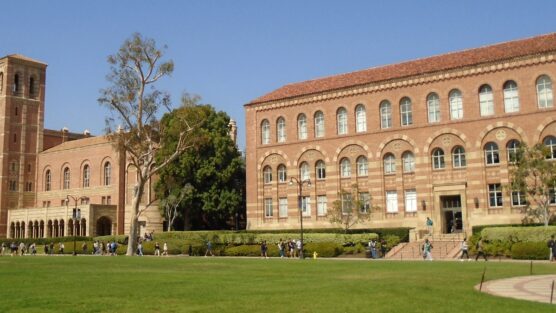Are you thinking about transferring? Do you want to game college admissions? Transferring is a tool you can use to help game college admissions as a whole, and in fact, there are also ways to game the system to increase your chances of getting accepted as a transfer student.
Apply to Schools with a High Transfer Rate
If you want to game the system of transferring, then you should look for schools where transfer rates are significantly higher than freshman admit rates. We took data from 100 top schools and looked up freshman and transfer admission rates for 2020. We also looked at the transfer rates for 2018 and 2019. Then, we compared the difference between freshman and transfer rates to determine which schools accept a significantly higher percent of transfer students.
Typically, people want to transfer to Harvard, Stanford, Princeton, and Yale. However, if you look at our data below, you can see that their transfer acceptance rates are extremely low. They are significantly lower than freshmen rates. The admit rate at Harvard, for example, was 5% in 2020, and the transfer rate was only 1.1%.
Transferring in 2020 vs. 2019
We have to admit that transferring is a bit of a fluke. For example, if 50 kids leave a top school one year to start the next, big tech company, more spots may open for transfer students. In general, transfer rates can fluctuate wildly. Dartmouth, for example, had a transfer rate of 28.6% in 2020– a 211% difference from its regular admit rate! However, if you look at 2018 and 2019, the rates are much lower at 1.5% and 4.1% respectively.
So, when looking at our data, we encourage you to take note of schools where the percent increase between freshman and transfer admit rates is at least 50% for both 2020 and 2019, or those two numbers average to at least 50%. Schools of note include the following: Vanderbilt, Northwestern, Barnard, USC, Washington University in St. Louis, University of Notre Dame, Boston University, University of Virginia, University of Michigan- Ann Arbor, UCLA, UC Santa Barbara, Tulane, and UNC-Chapel Hill. These schools are letting in a significantly higher percent of transfers than freshman admits.
You may wonder why schools have such high transfer rates. They are also trying to game the system. One way to increase their standing in rankings is to lower their admit rate as much as possible and raise the bar of what GPAs and test scores they want to see. This way, they get more elite candidates to apply.
Regular vs. Transfer Admission Rates
| School | 2020 Acceptance Rate | 2020 Applicants | Transfer admit rate 2020 | 2020 Transfer Applicants | Transfer rate 2019 | Transfer rate 2018 | Difference b/w regular and transfer admit rate 2020 | Difference b/w 2020 admit rate and 2019 transfer rate |
|---|---|---|---|---|---|---|---|---|
| Vanderbilt University | 11.6% | 36,646 | 36.8% | 1,738 | 22.8% | 25.2% | 217% | 97% |
| Dartmouth College | 9.2% | 21,392 | 28.6% | 273 | 4.1% | 1.5% | 211% | -55% |
| Boston University | 20.1% | 61,007 | 53.7% | 5,164 | 50% | 42.8% | 167% | 149% |
| Northeastern University | 20.5% | 64,459 | 48.4% | 3,099 | 16.1% | 31.1% | 136% | -21% |
| Tulane University | 11.1% | 43,892 | 25.8% | 1,221 | 38.6% | 38.2% | 132% | 248% |
| University of Notre Dame | 19.0% | 21,253 | 43.5% | 734 | 30.1% | 22.8% | 129% | 58% |
| Barnard College | 13.6% | 9,411 | 27.6% | 841 | 22.3% | 21.8% | 103% | 64% |
| New York University | 21.1% | 80,210 | 41.5% | 7,906 | 21.9% | 24.6% | 97% | 4% |
| UNC Chapel Hill | 23.5% | 44,382 | 44.6% | 3,289 | 49.4% | 35.4% | 90% | 110% |
| Georgia Institute of Technology | 21.3% | 40,852 | 38.3% | 2,253 | 27.3% | 29.3% | 80% | 28% |
| University of Virginia | 22.6% | 40,878 | 40.4% | 2,970 | 37.2% | 37.1% | 79% | 65% |
| University of Michigan Ann Arbor | 26.1% | 65,021 | 45.8% | 4,513 | 42.1% | 39.4% | 75% | 61% |
| American University | 38.7% | 20,036 | 67.3% | 1190 | 71.6% | 61.8% | 74% | 85% |
| Cornell University | 10.7% | 51,500 | 18.4% | 4,740 | 13.2% | 17.1% | 72% | 23% |
| Tufts University | 16.3% | 23,127 | 28% | 1,063 | 18.9% | 14.5% | 72% | 16% |
| UCLA | 14.3% | 108,877 | 24.5% | 26,127 | 22.8% | 24.1% | 71% | 59% |
| University of Southern California | 16.1% | 59,712 | 26.8% | 8,846 | 23.1% | 24.6% | 66% | 43% |
| Northwestern University | 9.3% | 39,263 | 15.4% | 2,434 | 16% | 15.3% | 66% | 72% |
| Washington University in St. Louis | 16.0% | 27,949 | 26.4% | 1,108 | 23.6% | 20.2% | 65% | 48% |
| University of Georgia | 48.3% | 28,024 | 79.0% | 2,525 | 70.1% | 75.6% | 64% | 45% |
| George Washington University | 43.0% | 26,405 | 70.3% | 2,588 | 39.1% | 40.5% | 63% | -9% |
| UC Santa Barbara | 36.6% | 89,752 | 59.3% | 18,984 | 51.1% | 56.6% | 62% | 40% |
| University of Miami | 33.1% | 40,131 | 52.0% | 2,567 | 50.9% | 53.5% | 57% | 54% |
| Emory University | 20.8% | 28,517 | 32.6% | 1,368 | 23.5% | 24.6% | 57% | 13% |
| Swarthmore College | 9.1% | 11,630 | 13.4% | 462 | 14.6% | 18.9% | 47% | 60% |
| UC San Diego | 38.3% | 100,073 | 55.9% | 21,123 | 56.2% | 49.5% | 46% | 47% |
| University of Richmond | 30.9% | 12,060 | 44.8% | 259 | 37.7% | 35.0% | 45% | 22% |
| William & Mary | 42.2% | 14,201 | 60.1% | 766 | 51.3% | 51.8% | 42% | 22% |
| University of Maryland | 51.0% | 32,211 | 70.4% | 6,664 | 61.7% | 56.8% | 38% | 21% |
| University of Florida | 31.1% | 48,193 | 42.9% | 5,931 | 40.3% | 47.0% | 38% | 30% |
| UC Irvine | 29.9% | 97,942 | 40.5% | 24,214 | 44.0% | 41.6% | 35% | 47% |
| Skidmore College | 32.2% | 10,433 | 42.8% | 166 | 37.0% | 41.9% | 33% | 15% |
| Ohio State University | 68.5% | 49,087 | 87.5% | 4,266 | 86.4% | 84.3% | 28% | 26% |
| UC Davis | 46.3% | 76,225 | 55.4% | 17,840 | NA | NA | 20% | NA |
| University of Connecticut | 56.1% | 34,437 | 66.9% | 2,046 | 72.2% | 61.1% | 19% | 29% |
| Berkeley | 17.5% | 88,076 | 20.6% | 20,443 | 23.0% | 20.7% | 18% | 31% |
| Temple University | 71.4% | 33,805 | 82.0% | 3,909 | 81.1% | NA | 15% | 14% |
| Santa Clara University | 50.7% | 16,488 | 58.0% | 1,006 | 52.0% | 45.6% | 14% | 3% |
| Rensselaer Polytechnic Institute | 57.3% | 16,661 | 65.1% | 373 | 58.6% | 57.3% | 14% | 2% |
| Smith College | 36.5% | 5,249 | 41.3% | 201 | 44.8% | 32.5% | 13% | 23% |
| Rice University | 11.0% | 23,455 | 12.4% | 816 | 7% | 11.4% | 13% | -36% |
| Case Western Reserve University | 30.3% | 29,084 | 33.5% | 570 | 24.9% | 22.8% | 11% | -18% |
| Kenyon College | 36.9% | 6,614 | 39.4% | 109 | 48.8% | 29.5% | 7% | 32% |
| Whitman College | 54.1% | 4964 | 57.1% | 140 | 49.20% | 43.80% | 6% | -9% |
| Colgate University | 27.5% | 8,583 | 28.8% | 320 | 20.8% | 21.8% | 5% | -24% |
| University of New Hampshire | 84.8% | 18,797 | 88.4% | 990 | 80.4% | 61.4% | 4% | -5% |
| Duquesne University | 77.2% | 8,335 | 78.9% | 748 | 82.8% | 87.9% | 2% | 7% |
| Villanova University | 30.7% | 22,083 | 31.1% | 444 | 28.3% | 25.0% | 1% | -8% |
| UT Austin | 32.0% | 57,241 | 32.4% | 6,925 | 27.9% | 23.9% | 1% | -13% |
| University of Vermont | 71.3% | 18,564 | 72.1% | 1,078 | 72.3% | 73.9% | 1% | 1% |
| Bucknell University | 37.5% | 9,890 | 37.4% | 222 | 31.9% | 22.1% | 0% | -15% |
| Texas A&M | 63.0% | 43,307 | 61.5% | 6,270 | 56.2% | 53.9% | -2% | -11% |
| Brandeis University | 33.4% | 10,223 | 32.4% | 629 | 20.4% | 24.6% | -3% | -39% |
| Washington and Lee University | 24.5% | 4,998 | 23.7% | 59 | 12.5% | 5.4% | -3% | -49% |
| Pepperdine University | 42.3% | 11,634 | 40.7% | 865 | 35.6% | 31.0% | -4% | -16% |
| Salisbury University | 77.6% | 8,701 | 72.2% | 1,408 | 74.2% | 69.8% | -7% | -4% |
| Florida State University | 32.5% | 63,691 | 30.2% | 7,752 | 29.3% | 28.5% | -7% | -10% |
| Rutgers University | 66.9% | 41,263 | 61.7% | 7,014 | 57.8% | 55.2% | -8% | -14% |
| Davidson College | 20.0% | 5,621 | 18.3% | 126 | NA | NA | -9% | NA |
| University of Wisconsin-- Madison | 57.2% | 45,941 | 51.9% | 3,525 | 45.7% | 53.4% | -9% | -20% |
| University of Wisconsin-Madison | 57.2% | 45,941 | 51.9% | 3,525 | 45.7% | 53.4% | -9% | -20% |
| University of Pennsylvania | 8.6% | 44,205 | 7.7% | 2,506 | 5.9% | 7.6% | -10% | -31% |
| Boston College | 26.4% | 29,382 | 23.6% | 1,589 | 19.2% | 33.7% | -11% | -27% |
| University of Delaware | 63.1% | 33,505 | 56.4% | 1,574 | 54.7% | 59.0% | -11% | -13% |
| University of Washington | 55.9% | 43,778 | 48.9% | 4,853 | 46.7% | 45.7% | -13% | -16% |
| University of Pittsburgh | 63.9% | 32,549 | 55.3% | 2,228 | 52.1% | 51.3% | -13% | -18% |
| Penn State | 54.2% | 73,861 | 45.9% | 2,141 | 43.1% | 46.3% | -15% | -20% |
| University of Colorado Boulder | 84.2% | 44,171 | 71.3% | 4,148 | 72.9% | 72.3% | -15% | -13% |
| University of Missouri | 81.8% | 20,641 | 68.9% | 2,903 | 67.6% | 65.4% | -16% | -17% |
| Indiana University Bloomington | 80.4% | 44,129 | 67.7% | 1,894 | 69.7% | 65.1% | -16% | -13% |
| Georgetown | 16.8% | 21,190 | 14.1% | 2,195 | 6.4% | 6.6% | -16% | -62% |
| Loyola University | 70.5% | 25,453 | 58.7% | 2,712 | 58.6% | 58.1% | -17% | -17% |
| Oberlin College | 35.4% | 9,309 | 28.3% | 223 | 26.4% | 32.4% | -20% | -25% |
| University of Oregon | 83.4% | 28,719 | 66.0% | 3,076 | 61.80% | 67.80% | -21% | -26% |
| California Institute of Technology | 6.7% | 8,007 | 5.2% | 96 | 6.3% | 1.9% | -22% | -6% |
| Michigan State University | 76.3% | 45,446 | 58.6% | 3,726 | 51.5% | 53.3% | -23% | -33% |
| Middlebury College | 22.0% | 9,174 | 16.6% | 211 | 12.5% | 9.1% | -25% | -43% |
| Stanford | 5.2% | 45,227 | 3.9% | 2,216 | 0.97% | 1.1% | -25% | -81% |
| University of Illinois-- Urbana Champaign | 63.3% | 43,473 | 47.3% | 4,254 | 49.1% | 51.0% | -25% | -22% |
| Bates College | 14.1% | 7,696 | 10.4% | 125 | 7.7% | 3.4% | -26% | -45% |
| Purdue University | 67.1% | 57,279 | 48.5% | 2,800 | 48.5% | 40.9% | -28% | -28% |
| Wake Forest | 32.0% | 11,959 | 22.7% | 269 | 26.3% | 5.3% | -29% | -18% |
| Reed College | 42.3% | 5,647 | 29.8% | 235 | 21.1% | 22.8% | -30% | -50% |
| Duke University | 7.7% | 39,717 | 5.4% | 1,274 | 6.1% | 6.6% | -30% | -21% |
| Scripps College | 35.1% | 2,938 | 24.5% | 163 | 23.0% | 16.1% | -30% | -34% |
| Lehigh University | 49.5% | 12,389 | 29.5% | 555 | 22.5% | 23.7% | -40% | -55% |
| Vassar College | 24.5% | 8,663 | 14.2% | 275 | 10.8% | 12.8% | -42% | -56% |
| Bryn Mawr College | 38.4% | 3,311 | 21.3% | 94 | 21.7% | 15.3% | -45% | -43% |
| Harvey Mudd College | 18.0% | 3,397 | 9.2% | 76 | 7.0% | 100.0% | -49% | -61% |
| Carnegie Mellon | 17.3% | 26,189 | 8.2% | 999 | 6.4% | 7.30% | -53% | -63% |
| Amherst College | 11.8% | 10,603 | 5.5% | 470 | 7.7% | 4.4% | -53% | -35% |
| Brown University | 7.7% | 36,793 | 3.5% | 2,293 | 5.8% | 7.7% | -55% | -25% |
| Massachusetts Institute of Technology | 7.3% | 20,075 | 3.1% | 673 | 3.1% | 4.3% | -58% | -58% |
| Wellesley College | 20.4% | 6581 | 7.5% | 214 | 8.9% | 16.2% | -63% | -56% |
| Princeton University | 5.6% | 32,835 | 1.7% | 905 | 1.4% | 0.91% | -70% | -75% |
| Yale University | 6.5% | 35,220 | 1.7% | 1,311 | 2.2% | 1.8% | -74% | -66% |
| Harvard University | 5.0% | 40,248 | 1.2% | 1,376 | 1.1% | 0.97% | -76% | -78% |
| Bowdoin College | 21.8% | 9,402 | 4.4% | 158 | 3.8% | 1.3% | -80% | -83% |
| Williams College | 15.1% | 8,745 | 2.5% | 356 | 3.9% | 3.1% | -83% | -74% |
| University of Rochester | 35.4% | 19,607 | NA | NA | NA | 23.2% | NA | NA |
Guaranteed Transfer Program
Another way to game the transfer system is through a Guaranteed Transfer program. Some institutions may admit you when you apply as a freshman, but they will ask you to go somewhere else for a year and then come back as a transfer. By doing this, they can pad their freshman admission rate and look exclusive. It also allows them to adjust their freshman admit data. They want the GPA and test scores of admitted students higher.
Schools like Georgia Tech, Texas A&M, UT Austin, Notre Dame, U Chicago, Cornell, USC, Tulane, UVA, and Boston University participate in this. We’re not sure how often these tactics are exercised. However, it is a tactic to help get into a school as a transfer. These programs may influence the data in our table above.
Community College
Community colleges often have special relationships with 4-year schools in their state. They may have guaranteed pathways to transfer to a 4-year institution. In California, many community colleges have pathways for admission to UC and CSU schools as long as you meet certain class and GPA requirements.
Some Ivy League institutions may prefer students transferring from a community college. For example, an Ivy League officer may prefer a community college transfer student to another Ivy League transfer student because they can help change their life. So, if you’re coming from a community college, and you’re excelling in that environment, it may be your advantage.
Don’t shun community college if you’re playing the transfer game. If you look for guaranteed pathways, you can find great opportunities and save a bundle of cash.
3+2 Programs
A 3+2 program is typically when you spend three years at a liberal arts college, and then two years at an engineering school. Usually, at the end of the program, a student receives a bachelor’s in science and a second degree from the liberal arts institution where they started. Instead of engineering, some programs can lead to nursing degrees. These allow you to take advantage of partnerships between schools. Often there is a somewhat guaranteed admission in these programs if you take certain classes and maintain a high GPA.
You may also find 4+1 programs where you can get a Masters’s degree at a partner university after undergrad. These programs could allow you to get a degree at a higher ranked, respected school after attending a smaller, liberal arts school.




